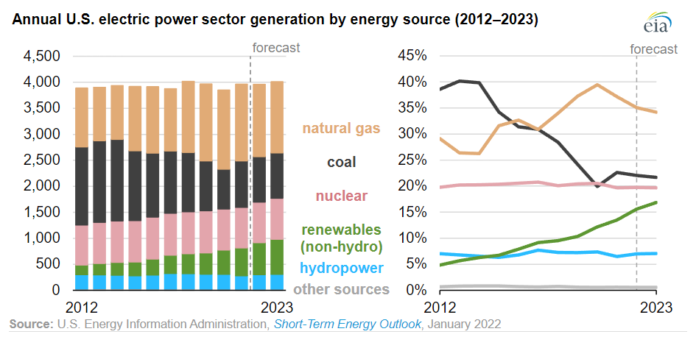
In U.S. Energy Information Administration’s (EIA) January Short-Term Energy Outlook (STEO), it forecasts that rising electricity generation from renewable energy resources such as solar and wind will reduce generation from fossil fuel-fired power plants over the next two years. The U.S. nonhydropower renewable energy sources will grow from 13% to 17% in 2021 to 2023, according to the EIA. EIA predicts that natural gas will account for 37% of the generation by 2021, 34% by 2023, and coal will be 23% to 22% by 2023.
The rapid expansion in renewable energy resources, including solar and wind has been one of the most significant changes in the mix U.S. electricity generation. The U.S. solar power generation capacity at the end 2021 is 20x greater than at the 2011 end, and the U.S. wind power capability is more than twice as large as it was 10 years ago.
Another important shift in the generation mix is the steady decline in coal-fired power plant output since 2007’s peak, and the growing use of natural gas, mainly due to low natural gas prices. This trend was reversed in 2021, when natural gas delivered to U.S. electrical generators cost an average of $4.88 per million British thermo units, more than twice the average cost in 2020. The result was that generation from natural gas fell from 39% to 37% in 2020 to 37% last, while it rose from 23% to 23% for the first time since 2014.
EIA’s current STEO predicts that new renewable energy sources will account for most of the U.S. growth in electricity generation in 2022-2023. According to the organization, the electric power sector had 63 gigawatts of solar power generation capacity at the end 2021. The annual growth of solar power generation capacity is expected to be approximately 21 GW in 2022, and 25 GW 2023. EIA projects that 7 GW additional wind generating capacity can be added in 2022, and another 4GW in 2023. The total operating wind capacity stood at 135 GW as of 2021.
EIA’s forecasts of growth in renewable electricity generation over the next two years leads to a forecast of a reduced need for fossil-fueled generation. EIA expects natural-gas prices to fall for electric generators, but the operating costs of renewable generators will remain lower than those of natural gas-fired units. The largest reductions in natural gaz generation will occur in the areas of the country that have the highest renewable capacity increases, such as Texas and the Midwest/Central. The full report is available here.
In U.S. Energy Information Administration’s (EIA) January Short-Term Energy Outlook (STEO), it forecasts that rising electricity generation from renewable energy resources such as solar and wind will reduce generation from fossil fuel-fired power plants over the next two years. The U.S. nonhydropower renewable energy sources will grow from 13% to 17% in 2021 to 2023, according to the EIA. EIA predicts that natural gas will account for 37% of the generation by 2021, 34% by 2023, and coal will be 23% to 22% by 2023.
The rapid expansion in renewable energy resources, including solar and wind has been one of the most significant changes in the mix U.S. electricity generation. The U.S. solar power generation capacity at the end 2021 is 20x greater than at the 2011 end, and the U.S. wind power capability is more than twice as large as it was 10 years ago.
Another important shift in the generation mix is the steady decline in coal-fired power plant output since 2007’s peak, and the growing use of natural gas, mainly due to low natural gas prices. This trend was reversed in 2021, when natural gas delivered to U.S. electrical generators cost an average of $4.88 per million British thermo units, more than twice the average cost in 2020. As a result, generation from natural gases fell from 39% in 2020, to 37%, and that of coal increased for the first year since 2014, to an average 23%.
EIA’s current STEO predicts that new renewable energy sources will account for most of the U.S. growth in electricity generation in 2022-2023. According to the organization, the electric power sector had 63 gigawatts of solar power generation capacity at the end 2021. The annual growth of solar power generation capacity is expected to be approximately 21 GW in 2022, and 25 GW 2023. EIA anticipates that 7 GW more wind generating capacity will be available in 2022, and 4 GW more in 2023. The total operating wind capacity stood at 135 GW as of 2021.
EIA’s forecasts of growth in renewable electricity generation over the next two years leads to a forecast of a reduced need for fossil-fueled generation. EIA expects natural-gas prices to fall for electric generators, but the operating costs of renewable generators will remain lower than those for natural gas-fired units. The largest reductions in natural gaz generation will occur in the areas of the country that have the highest renewable capacity increases, such as Texas and the Midwest/Central.
The full report is available here.
